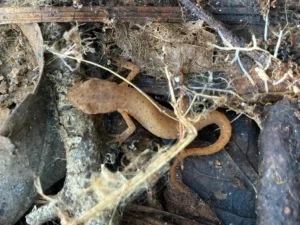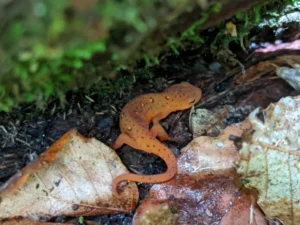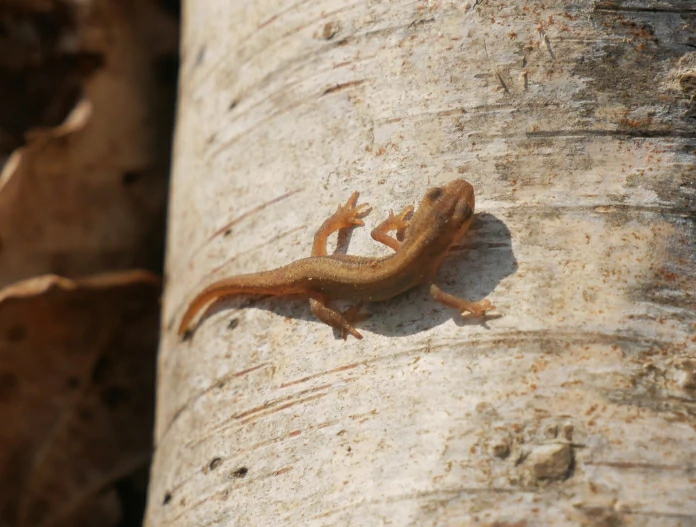You’re walking along a damp forest path after a spring rain and spot a newt slowly crawling over a fallen branch. For a moment, you wonder, if it can get over this log, could it keep going higher? Can newts climb trees?
Newts aren’t natural tree climbers, but some can crawl short distances up rough bark, mossy stumps, or tall plants. They stick close to the ground because that’s where their food and moisture are, and they don’t have the special toe pads that tree frogs or geckos use to climb.
Still, asking the question opens a window into how newts move, where they go, and what their bodies are made for.
Why People Think Newts Might Climb Trees
It’s easy to think they climb. Many amphibians can, and if you’ve seen a frog on a window or a salamander on a branch, it’s natural to wonder about newts.

After rain, newts often sit on damp logs, leaning reeds, or mossy rocks. When one rests halfway up a clump of grass, it looks like it’s heading into the trees.
In reality, it’s just exploring low plants, not climbing high.
That image sticks, though, the slow crawl of a bright little creature against green moss.
So it’s normal to ask: if frogs and some salamanders can climb, why not newts?
How a Newt’s Body Is Built for Movement
The answer starts with their bodies. Newts are built for crawling, not scaling walls. Their legs stretch out from their sides, keeping their bellies close to the ground.

This gives balance in mud, leaves, and shallow water, but doesn’t help with vertical climbing.
Their toes are small, round, and clawless. They press against surfaces rather than gripping or sticking.
That works great on mud or moss, but on smooth tree bark or dry rock, it’s almost useless.
Watching a newt move shows it clearly. Each step is careful, deliberate, testing the surface with its whole body.
They aren’t made for quick jumps or daring climbs, they’re made for patience.
Can Newts Climb Vertical Surfaces?
So can they climb at all? Yes, but only on certain surfaces.
If a newt finds a mossy wall, damp soil bank, or fallen log, it can inch upward. Its belly stays close, toes spread, and the body helps balance.
It’s slow and awkward, but it works.

What they can’t do is cling to smooth, dry, or steep surfaces. A bare tree trunk with flaky bark is already too much.
A brick wall or glass? Forget it. Without sticky pads or claws, gravity wins.
So “vertical climbing” usually just means short climbs on damp, rough, textured surfaces.
Why Newts Rarely Go High Into Trees
Even if a newt could climb higher, there’s little reason to. Think about what it needs most: food and moisture.
On the forest floor, worms, slugs, and insects are plentiful. In water, there are larvae, snails, and tiny fish. Up in the branches, there’s nothing to eat.
Moisture is another limit. Newt skin must stay damp to breathe and stay healthy. Higher in a tree, bark is dry, air is breezy, and sunlight is stronger.
Climbing far from the ground risks drying out too quickly.
Even if their bodies allowed it, survival keeps them low.
Where You’re Most Likely to See a “Climbing” Newt
If a newt looks like it’s climbing, it’s probably close to the ground. Maybe it’s on a mossy stump after rain, or partway up a stone near a pond.

Sometimes they move partway up tall grasses or reeds to rest on humid evenings.
To someone watching, it may look like the start of a tree climb. But they usually stop after a few inches. Newts explore low spaces, not high ones.
Do Some Newts Climb More Than Others?
Not all newts are the same. Some are slightly more adventurous:
-
Eastern Newts in North America may crawl up stalks of vegetation near ponds.
-
Smooth Newts in Europe sometimes perch on mossy roots or low rocks after rain.
-
Fire Belly Newts in Japan may climb onto floating water plants.
Notice the pattern: they stick to damp, low, textured surfaces, not towering trunks.
None are adapted for real climbing like frogs or tree salamanders.
How Newts Compare to Other Amphibians
Tree frogs are famous for sticky toe pads, letting them cling upside down on glass. Arboreal salamanders in California have strong toes for climbing bark.

Newts are more like ground-dwelling salamanders.
They trade climbing for endurance, moving slowly but steadily through moist, covered spaces.
In the amphibian lineup, newts are clearly “ground specialists.”
Could a Newt Fall From a Climb?
Falls can happen, but rarely cause harm. A newt slipping down a damp stump usually lands safely because it’s small and light.
The bigger danger is drying out. If it ended up partway up a sunny, dry trunk, it could lose moisture before getting back to safety.
What If You Spot a Newt on a Tree?
Sometimes hikers report newts partway up tree trunks. Most of the time, they’re on moss, lichens, or rough bark near the base.
This isn’t climbing like frogs or geckos, it’s exploring a damp surface.
If it seems higher than that, it might not be a newt at all. Frogs, small salamanders, or lizards are often mistaken for them.
Newts stay low, and spotting one high up would be extremely rare.
Why Climbing Isn’t Part of Their Life Cycle
Newts start life as larvae in ponds, breathing through gills. Then they turn into juveniles, crawling onto land as efts. Later, they go back to water as adults.
At no stage do they need to climb trees. Their world is split between water and ground, not ground and canopy.
Everything they need (shelter, food, and safety) is there.
Do Newts Prefer Digging Instead of Climbing?
Instead of going up, newts often go down. They slip under leaves, crawl into soil cracks, or use burrows. These spots keep them cool, damp, and safe from predators.
This digging shows the opposite of climbing, they look for cover below rather than adventure above.
Conclusion
Newts spark curiosity because of their slow, quiet movements and secretive lives. Seeing one halfway up a mossy root makes you wonder if it could go higher.
But newts stick to the ground and water. Unlike frogs with sticky toes or salamanders built for climbing, they aren’t made for trees.
Next time you’re in the forest, keep your eyes low. Look near damp logs, under leaves, and along pond edges. That’s where newts live; the hidden, moist world right under your feet.
Hi, my name is Ezra Mushala, i have been interested animals all my life. I am the main author and editor here at snakeinformer.com.

